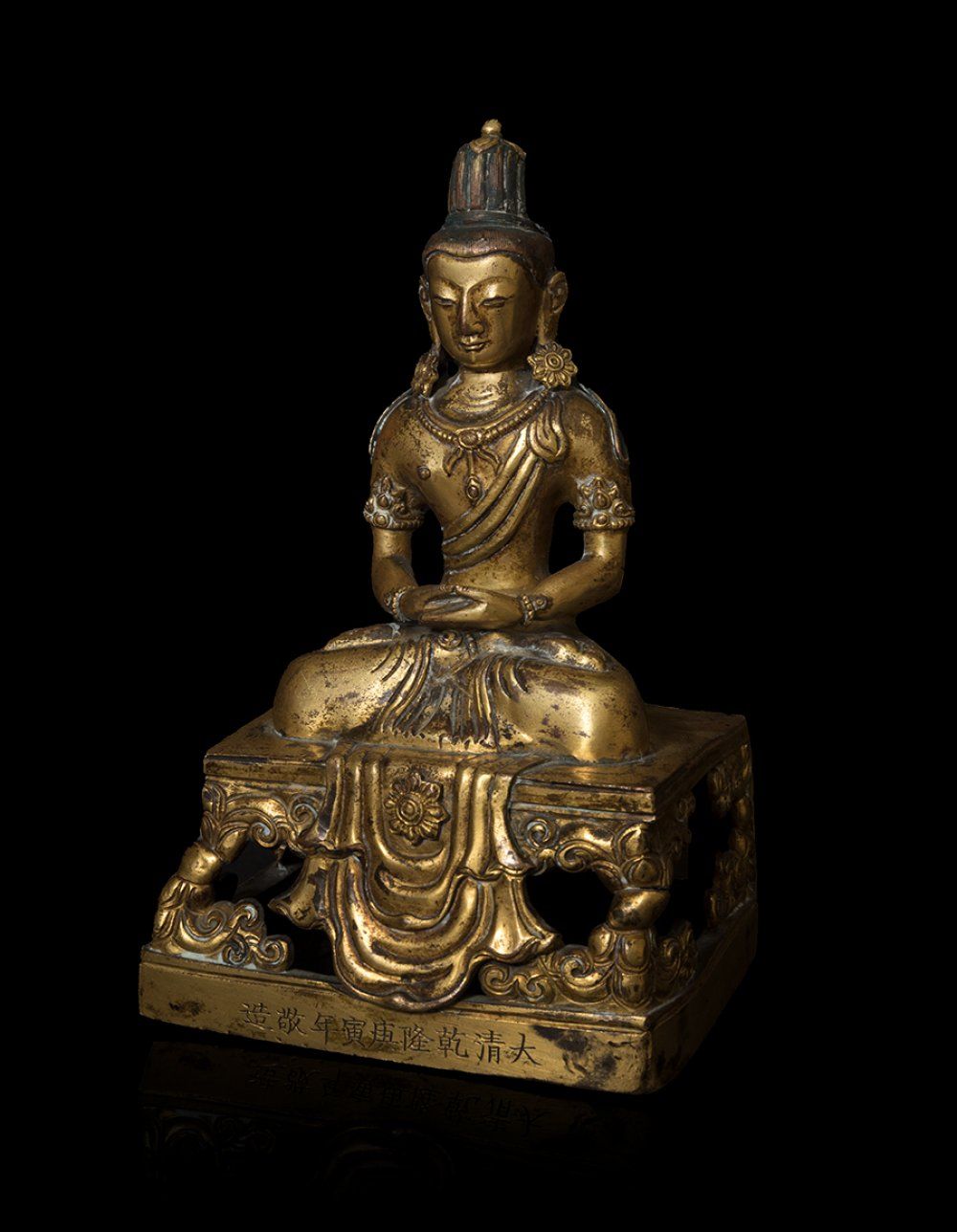Description
Buddha; China, Quing Dynasty, 17th-18th century. Gilt copper. Presents seals. Measurements: 19 x 11.5 x 9 cm. The position of the hands and the posture of the figure indicate that it is a representation of Amitayus, the Buddha of Infinite Life. This is the long-lived aspect of the Buddha Amitabha. Amitayus is depicted with singular refinement in this gilded bronze sculpture. Seated in the lotus position, with his hands clasped around his lap and palms upwards, he adopts a mudra, or gesture. The figure stands on a square pedestal, the lower part of which is decorated with calligraphic inscriptions. Above the foot stands the structure on which the richly ornamented Buddha-figure sits, from the base of which the folds of the cloth seem to descend, adorned with a lotus flower, a recurring theme in the representation of life. In a hieratic and stylised manner, the figure of the Buddha is presented seated in a lotus-flower position and performing a sacred gesture or mudra. The base, also in bronze, evokes a synthetic lotus flower, worked at different levels. The representation shows several "lakshana", iconographic symbols that identify the Buddhas and bodhisattvas. The first one we see is the chignon hairstyle, a symbol of meditation, concentrated spiritual life and wisdom. Above the headdress, a flame symbolises the light of enlightenment. The eyelids are a symbol of spiritual concentration and also of purity, due to their similarity to the petals of the lotus, and complete a serene face with a sketched smile, symbolising the balance and serenity of a perfect being. The elongated earlobes, in this particular case adorned with lotus flowers as earrings, allude to the large earrings worn by members of the upper classes in India at the time of Sakyamuni, and represent the concepts of greatness, nobility and wisdom. Buddha attained the ultimate evolutionary perfection, turning suffering into happiness for all living beings. Born around 560 BC, his father was a raja who ruled the north-eastern province of India. At the age of 29, the young prince gave up his life of luxury, as he felt compelled to purify his body and turn it into an instrument of the mind by ridding it of earthly temptations.
4
Buddha; China, Quing Dynasty, 17th-18th century. Gilt copper. Presents seals. Measurements: 19 x 11.5 x 9 cm. The position of the hands and the posture of the figure indicate that it is a representation of Amitayus, the Buddha of Infinite Life. This is the long-lived aspect of the Buddha Amitabha. Amitayus is depicted with singular refinement in this gilded bronze sculpture. Seated in the lotus position, with his hands clasped around his lap and palms upwards, he adopts a mudra, or gesture. The figure stands on a square pedestal, the lower part of which is decorated with calligraphic inscriptions. Above the foot stands the structure on which the richly ornamented Buddha-figure sits, from the base of which the folds of the cloth seem to descend, adorned with a lotus flower, a recurring theme in the representation of life. In a hieratic and stylised manner, the figure of the Buddha is presented seated in a lotus-flower position and performing a sacred gesture or mudra. The base, also in bronze, evokes a synthetic lotus flower, worked at different levels. The representation shows several "lakshana", iconographic symbols that identify the Buddhas and bodhisattvas. The first one we see is the chignon hairstyle, a symbol of meditation, concentrated spiritual life and wisdom. Above the headdress, a flame symbolises the light of enlightenment. The eyelids are a symbol of spiritual concentration and also of purity, due to their similarity to the petals of the lotus, and complete a serene face with a sketched smile, symbolising the balance and serenity of a perfect being. The elongated earlobes, in this particular case adorned with lotus flowers as earrings, allude to the large earrings worn by members of the upper classes in India at the time of Sakyamuni, and represent the concepts of greatness, nobility and wisdom. Buddha attained the ultimate evolutionary perfection, turning suffering into happiness for all living beings. Born around 560 BC, his father was a raja who ruled the north-eastern province of India. At the age of 29, the young prince gave up his life of luxury, as he felt compelled to purify his body and turn it into an instrument of the mind by ridding it of earthly temptations.
